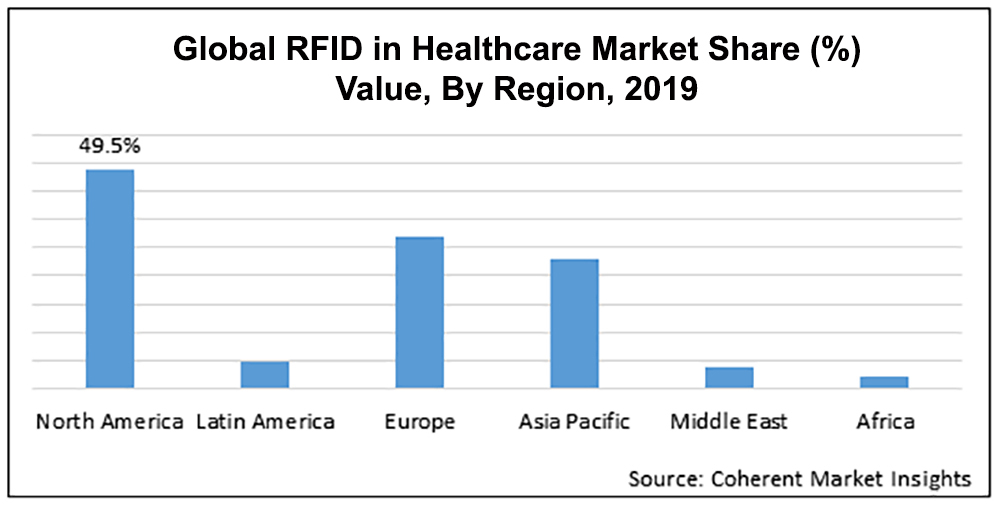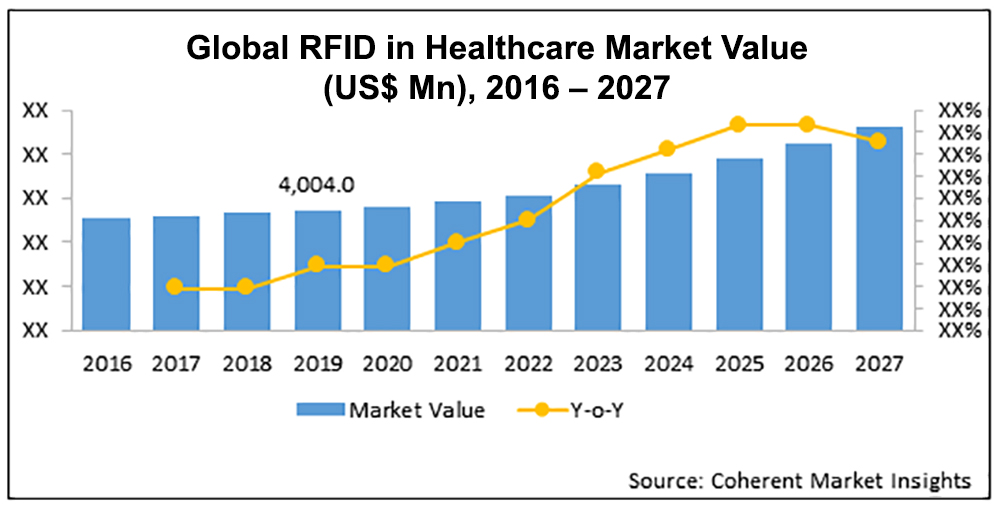Mar 01, 2021Due to a combination of market demand, regulations and technology development, the global market for radio frequency identification in the healthcare sector may grow to approximately $16.76 billion by the end of 2027, representing an annual growth rate of 19.6 percent. That's according to research conducted by Coherent Market Insights.
The growth of RFID, including both ultrahigh-frequency (UHF) and high-frequency (HF) passive tag-based systems, to track everything from pharmaceuticals and medical devices to documentation and hospital assets is being fueled by multiple factors, the research indicates. The prevalence of drug counterfeiting, patient-safety concerns, the need to improve efficiency, and the development of more effective and affordable technologies are converging to create the forecasted growth, the analyst firm found.

The study, titled "RFID in Healthcare Market," was completed in September 2020, and it found that while RFID technology use in healthcare had reached $4 billion in 2019, it will be about four times that amount by 2027. "Applications of RFID in the healthcare industry are still at a very nascent stage, with enormous potential opportunities," says Raj Shah, Coherent Market Insights' strategy consultant, adding that RFID system designs have room for improvement before the technology will gain full acceptance in healthcare applications. The study is a blend of both primary and secondary research, he explains. Analysts conducted primary interviews with large and medium-sized hospitals, pharmaceutical and medical device companies, manufacturers, distributors, and supply chain and logistics firms.
The team launched the study at the request of an unnamed manufacturer of technology that includes RFID tags, explains Kamrul Hasan, Coherent Market Insights' senior consultant. "[The] client was interested to know the demand, revenue, growth trends, preference, etc., of RFID in the market," he says, and it wished to learn strategies adopted by other vendors. North America currently holds the dominant position in the RFID market, followed by the Europe and Asia-Pacific regions, the report finds. The researchers determined that dominance is based on healthcare expenditures, the rising adoption of new technologies, technological innovations and regulatory compliance.

Raj Shah
The authenticity and identification of products are major driving factors for the use of RFID, according to Hasan. "Problems like drug counterfeiting, such as tampering with products, are the major causes of errors in the supply chain, which can be traced and prevented by RFID tagging." The researchers found that medical device tracking and asset management have become primary concerns in the healthcare industry and are being addressed by the use of RFID. That can mean applying tags to assets being tracked via fixed portal or handheld readers to capture their last-seen locations.
"COVID-19 has played a role in RFID technology uptick, as it has prompted the healthcare industry to adopt contactless patient care and healthcare delivery," Hasan says. By adopting RFID, he explains, companies have greater asset-management visibility, ensuring that they have the tools they need at hand during such events as a surge in patients caused by the pandemic.
The adoption of RFID by pharmaceutical companies and distributors is another major factor for market growth, according to the report. Drug regulations have been requiring the unique identification of each product unit according to supplier name, manufacturer name, product name, batch numbers, quantity, manufacturing and expiry dates, and other information. In addition, Hasan says, "There is a list of certified vendors from which a particular material must be purchased. If each arriving container has an RFID tag, it is very easy to identify the suppliers or manufacturers."
Another expanding use case for RFID is in the area of document management for pharmaceutical and healthcare companies. The researchers found that some documents, such as those containing pharmaceutical product development data, product stability data, technical audit reports and product recalls, as well as market complaints, need to be accessible for various parties. RFID, the report indicates, can automate this process.

"RFID tagging on such documents can prevent the movement of such documents in and out from these premises," Hasan states. RFID-tagged paper typically provides a barcode and an embedded RFID chip, and this can be printed from an RFID-enabled printer. Increasingly, the researchers found, companies are beginning to use, or are already using, RFID (typically UHF) to address security issues related to the physical movement of confidential documents.
On the part of RFID technology vendors, the effort to develop more effective and affordable technology has paid off, according to the study. Vendor efforts include the launch of medical devices with RFID readers. One example the report cites is Dentsply Sirona's CEREC Primemill grinding and milling machine, which comes with a built-in RFID reader. "This development of innovative RFID reader technology for medical devices can help the device manufacturers to gain an extra competitive advantage in the market and also benefit the end user," Hasan states.

Kamrul Hasan
The study found that RFID technology provides the ability to automate and thereby simplify time-consuming tasks in the pharmaceutical industry, by reducing times by approximately 20 to 30 percent. Such tasks include the recording and storing of data related to drug development, as well as the capturing of information regarding the use and sale of biological products, all of which can be automated. RFID is also being used to reduce drug administration and dispensing errors, Hasan reports.
According to Hasan, the demand for greater visibility to ensure patient safety has been driving further interest in and deployment of RFID solutions. "Patient safety is very important for hospitals and healthcare providers," he explains, and automating the tracking of equipment and medical devices can prevent loss and save time healthcare workers would otherwise spend searching for those goods. "Tracking such medical devices, especially expensive assets, is of the utmost priority for healthcare organizations, to prevent untoward incidents such as theft of devices."
Finally, the study found that the key to much of the growth in RFID is tag price, which has dropped substantially in the past 15 years. "The trend will continue," Hasan predicts, "and each tag will possibly cost 5 cents in the next five years." This cost reduction is based on the economy of scale led by the demand for RFID in retail (for inventory tracking), and in aerospace and defense (for asset tracking and supply chain management, as well as baggage tracking at airports).
Additionally, the report concludes, RFID's growth in manufacturing (for monitoring work-in-progress, production control, process optimization and quality control), and for e-commerce (for better-targeted advertising campaigns and repeat customers) has driven down tag costs.

